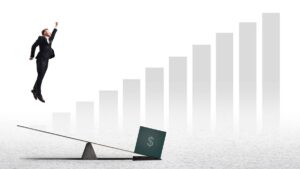Stronach on Stronach: An Idiot’s Guide to Stock Buybacks For Dummies™

'Gaaargh! If only there were an easier way to figure out what time it is!' Picture: Getty Images
Welcome to Stockhead’s new series where our Lunch Wrap editor Gregor Stronach draws upon some three decades of journalism experience writing about cars, video games, true crime, awkward celebrity encounters and near-death surgical episodes in order to explain complicated market concepts.
This is not financial advice. But it’s definitely more interesting.
In the past few weeks, there’s been a surge in companies announcing stock buybacks. If you’re baffled what that means, then prepare to be unbaffled.
One of the questions we get asked a lot here by Stockhead’s readers is “What is wrong with you?” – but we also get questions from market newcomers to explain certain things that don’t involve our somewhat perilous mental states.
The past few weeks have been busy ones on the ASX with reporting season in full swing and the company announcements have been flying in thick and fast.
It’s usually around this time that we see an appreciable uptick in one particular event, and that’s announcements from companies large and small (but mostly large) that the board has decided that the time is right for a stock buyback.
So, join me as I fall back on the laziest trick in the journalism book, and ask a series of questions and then provide the answers, like a lunatic talking to himself at the bus stop.
What is a stock buyback?
A stock buyback occurs when a company’s board decides that the time is right to start spending money to buy back a bunch of the shares that have been sold to shareholders while the company has been publicly traded.
There are a few permutations of that process, but they all amount to pretty much the same thing – less shares in the hands of shareholders, at the expense of the business’ bottom line.
It is, in essence, a method of capital management. It will eat into the company’s cash reserves, sure, but (and this bit’s important), the process works similarly to this anecdote.
I’ve got a mate who’s deeply involved in the world of phliat phlialti stamp collecting, and he told me the (probably 100% untrue) story of something he saw at a high-end auction in Europe.
A particularly rare stamp was up for sale – one of only 11 or 12 known to exist – and the bidding moved at breakneck speed, rocketing past the reserve price and well past even the most optimistic forecasts.
It was eventually won by a German guy, who wrote a cheque for the horrendously large sum of money he’d bid, walked to where his new stamp was on display, took it from its perspex case and tore it up in front of a visibly shocked room full of stamp nerds.
The fella explained shortly afterwards that he’d done that so that the two identical stamps he already owned would vastly increase in value, because there were now less of them left in the world.
Aside from being a massive act of bastardry, it kind of made sense.
Stock buybacks operate on a similar underlying idea, but there’s a little more to it – and some good ol’ fashioned learnin’ to be done so you can grasp not just what a buyback is, but why they work, as well.
Okay, but why?
Ask anyone on the company side of things, and they will tell you – with a straight face and everything – that the reason companies hold buybacks is to return money (in one form or another) back to shareholders.
Shareholders normally make money from owning shares in two ways – they can either sell their shares when they’ve reached a value point that makes selling them worth their while, or they can hold their shares and the company can pay shareholders dividends, a small per-share payment valued at a fraction of the current market value of those shares.
But there is a third way, shrouded in mystery and known only to the chosen few who, like me, burned several more hours than this should have taken and looked it all up, so you didn’t have to.
I apologise in advance, though, because there’s something that needs explaining first so that the explanation of the original thing makes sense.
We need to talk about metrics. And stuff.
Can you please give us a long, tedious analogy?
Of course! There are as many permutations and formulas for determining just how excellent a company is, or isn’t, and one of those is the wildly popular Price-to-Earnings, or P/E ratio.
The P/E ratio is derived from a simple formula, which is “market value per share ÷ earnings per share” – and is as good at taking the temperature of a company as throwing a thermometer up the wrong end of a cat to see if it’s crook, or just… being a cat.
The best analogy I could muster is to think about a company’s P/E ratio the same way you think about the gear ratios in your car.
There are gears for moving forward, which come in either “high” or “low” flavours, and the always fun but often deadly “reverse”.
A company with a positive P/E ratio is one that’s probably doing okay, and – all things remaining equal – will continue to do so, massive disasters notwithstanding.
When the P/E ratio is nominal, it’s like a car in a lower gear, moving along sedately with little risk to the occupants or anyone else around it, because there’s plenty of time to avoid sudden collisions, like the CEO getting caught with one hand in the till and the other in his secretary.
But when the P/E ratio climbs too high, it’s like a car roaring along in a higher gear, moving much faster than the speed limit.
That’s because it’s been understood for quite some time that when a company’s P/E climbs too high, it starts to get into the portion of the market that some people like to call “volatile”, and others refer to as “degenerate gambling”, so it’s a riskier investment.
And then there are companies that sport a negative P/E ratio, because they’re spending more than they earn – best illustrated by considering the way a WWII-era French tank would function.
They were excellent at moving forward – albeit mostly at a pace best described as “glacial” – right up until there was the slightest hint of trouble.
At that point, the tank driver would engage one of the 17 reverse gears lovingly built into each tank, retreat at high speed for a short period of time before capitulating entirely and surrendering.
So… backwards is Not Great, too fast is Not Great, but there is definitely a Goldilocks Zone for a company’s P/E.
Which, of course, takes some explaining as well. Sorry. I could have just sent you to Eddy Sunarto’s grown-up version.
Dude, Seriously?
Yes, seriously – because there is a sweet spot for a company’s P/E ratio, but it’s impossible to settle with any certainty on a single figure for it that is objectively “good”. What works for one industry (or part thereof) might not work for another.
For example, you’d be somewhat foolish to try to compare the P/E of a Materials sector exploration company to that of a Materials sector mining company to see which one’s a “better company”.
Exploration companies often have ludicrous P/E figures, because there’s more to figuring out where gold is than wandering about aimlessly with a metal detector, hoping for the best.
Actual minerals exploration is pricey.
So the up-front cost of exploring often means that those companies are operating at a severe deficit for years before they accidentally drill all the way through the Earth and into that room where Scrooge McDuck likes to swim in his vast pool of gold coins.
Compare that to a company that has either finished with exploration and is actively operating its mine (or, more likely, has given an exploration company the payday investors had been hoping for) and is now extracting as much gold or lithium or whatever as possible to sell and show a profit.
While that makes P/E a bit of a blunt instrument, it does give investors something to ponder before they get their money in, and it gives the board a target, and a lever to move things around if that P/E needs to be improved.
The two ways for a company to improve its P/E is to either reduce its earnings (a move widely considered to be no bueno) or increase its share price, but most of the simple ways of doing that are massively illegal, for obvious reasons.
But one way that a company can control to increase its share price is to use the basic market force of scarcity to drive it up – like the stamp guy we mentioned before.
So, this is when the buyback happens – when there’s money in the coffers that can be spared, it gets spent on buying up a bunch of shares, which are then taken out the back and shot.
Basically, a company does a buyback because it has money to invest and it cannot find a better investment than itself.
That also leaves less shares available, which – according to Buffet’s Third Law of Thermofinancials – makes them intrinsically more valuable, as each remaining share now represents a larger slice of the company pie.
Which, in turn, means shareholders will make more money, which in turn makes those shareholders happy, which in turn makes life for the CEO and the board much easier, because the AGM of a company with happy shareholders usually involves little, if any, furniture being flung at the stage.
The poster child for buybacks is Apple. Between the golden years of tech (2018 and 2022 ATH), Tim Cook and his mates spent close to half a trillion USD buying back the farm, reducing its share count from 19.4 billion to 16.4 billion.
In that time, its market cap rose about 200%. Tidy, but wait… its stock price rose 252%. That’s the classic definition of “everyone kicks a goal”.
But how come I heard that buybacks are terrible, evil things?
Because Australia’s disproportionately noisy Neo-Marxist Collective types don’t like it when shareholders make money, because that money could be better spent on paying workers a fair wage for providing the labour that produces the actual value of the company, or other trifling frivolities like improving worker safety or better environmental practices, despite the fact that 99.9% of them are relying on this precise system to ensure they aren’t living in a box and eating newspapers when they retire, because the only reason their superannuation is growing at all is because it’s been invested in publicly listed companies, making them shareholders.
That’s why.
UNLOCK INSIGHTS
Discover the untold stories of emerging ASX stocks.
Daily news and expert analysis, it's free to subscribe.
By proceeding, you confirm you understand that we handle personal information in accordance with our Privacy Policy.








